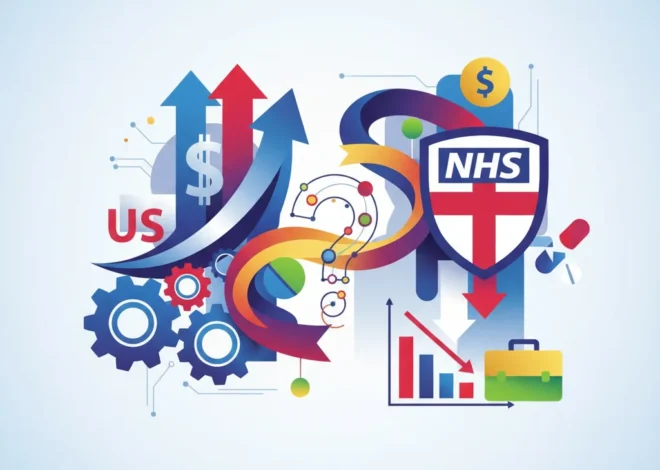
The Rybelsus Revelation: Why One Chart Correction Unlocks Novo Nordisk’s True Value
In the fast-paced world of finance and investing, information is currency. A single data point, a misplaced comma, or an overlooked footnote can be the difference between a savvy investment and a costly mistake. Recently, the Financial Times issued a brief but significant correction regarding an article on the pharmaceutical giant Novo Nordisk. The correction noted that a chart of the company’s projected sales had mistakenly grouped its diabetes medicine, Rybelsus, with its blockbuster obesity drugs (source). To the casual observer, this might seem like a minor clerical error. But for anyone involved in the stock market, trading, or corporate finance, this small clarification is a masterclass in why meticulous analysis is paramount.
This isn’t just about a chart; it’s about understanding the nuanced, multi-billion dollar engines driving one of the world’s most valuable companies. Lumping Rybelsus in with drugs like Wegovy is like combining a steady, reliable dividend stock with a high-growth tech startup. Both have value, but their risk profiles, market dynamics, and growth trajectories are fundamentally different. Unpacking this distinction reveals the core of modern pharmaceutical economics and offers a crucial lesson for investors trying to accurately value a company that has single-handedly reshaped Denmark’s entire economy.
The Science of a Super-Drug: Understanding GLP-1 Agonists
At the heart of Novo Nordisk’s meteoric rise is a class of drugs known as glucagon-like peptide-1 (GLP-1) receptor agonists. Originally developed to treat type 2 diabetes, these drugs mimic a gut hormone that stimulates insulin secretion, suppresses glucagon production, and slows gastric emptying. The result is better blood sugar control. However, a powerful side effect emerged during clinical trials: significant weight loss. Patients felt fuller for longer and experienced a reduced appetite.
This discovery was a watershed moment. Novo Nordisk cleverly leveraged the same active ingredient, semaglutide, to target two distinct, massive markets:
- For Diabetes: Marketed as Ozempic (injectable) and Rybelsus (oral).
- For Obesity: Marketed as Wegovy (a higher-dose injectable).
While the underlying molecule is the same, the branding, dosage, target audience, and—most importantly for our analysis—the market economics are worlds apart. This strategic segmentation is a brilliant business move, but it’s also why the initial chart’s oversimplification was so misleading for anyone building a financial model.
The New Financial Frontier: Decoding the Fintech and Blockchain Revolution
A Tale of Two Markets: Diabetes vs. Obesity
The distinction between the diabetes and obesity markets is the central theme of this financial detective story. An investor must analyze them as separate revenue streams with unique characteristics. The original chart’s error was in blending these streams, creating a distorted picture of future growth and profitability.
Let’s break down the key differences between the Rybelsus (diabetes) and Wegovy (obesity) markets. This comparison highlights why they must be evaluated independently in any serious financial analysis.
| Factor | Rybelsus (Diabetes Market) | Wegovy (Obesity Market) |
|---|---|---|
| Primary Indication | Type 2 Diabetes Management | Chronic Weight Management (Obesity) |
| Market Maturity | Established, mature market with entrenched competitors. | Explosive, high-growth market with enormous untapped potential. |
| Patient Profile | Patients with a specific medical diagnosis (diabetes). | A much broader potential audience, including those seeking weight loss for lifestyle and preventative reasons. |
| Insurance & Reimbursement | Generally well-covered by insurance as a medically necessary treatment. | Coverage is inconsistent; often classified as a “lifestyle” drug, leading to high out-of-pocket costs for many. |
| Growth Driver | Steady growth, innovation (oral delivery), and market share gains. | Exponential growth driven by unprecedented demand, social trends, and expanding indications. |
| Financial Profile | Stable, predictable revenue stream forming a solid base for the company. | Volatile but potentially astronomical revenue stream, subject to supply constraints and reimbursement hurdles. |
As the table illustrates, Rybelsus provides a foundational, predictable revenue base. It’s a critical part of Novo Nordisk’s portfolio, especially as the first oral GLP-1, which offers a significant convenience advantage. Conversely, Wegovy is the high-octane growth engine. The potential market for obesity treatment is vast, with some analysts projecting it could exceed $100 billion by 2030. However, this growth is contingent on overcoming manufacturing bottlenecks and securing broader insurance coverage, making it a higher-risk, higher-reward proposition.
The Investor’s Bottom Line: Why Precision in Financial Modeling is Non-Negotiable
For anyone involved in finance or trading, the FT’s correction is a potent reminder of the “garbage in, garbage out” principle of financial modeling. A company’s stock price is, in theory, the sum of all its future discounted cash flows. The projections that feed these models—like the sales figures in the chart—are the bedrock of a valuation.
Here’s why conflating the sales of Rybelsus and Wegovy is a critical analytical flaw:
- Distorted Growth Rates: By combining a steady-growth product with a hyper-growth product, the overall projected growth rate becomes an unhelpful average. This can lead an investor to either underestimate the explosive potential of the obesity franchise or overestimate the growth of the more mature diabetes segment.
- Inaccurate Margin Analysis: The profitability (gross margin) of these drugs can differ based on pricing, rebates to insurers, and manufacturing costs. Blending them obscures the true profitability of each business unit, making it harder to forecast future earnings accurately.
- Misjudgment of Market Risk: The risks associated with each market are different. The diabetes market faces competitive pressure and patent cliffs, while the obesity market faces risks from reimbursement policy, public perception, and long-term safety data. A proper risk assessment requires segmenting these revenue streams.
This level of detail is precisely what separates institutional analysis from retail speculation. Investment banking analysts spend their careers dissecting these revenue streams to arrive at a price target. Their models are incredibly sensitive to these inputs. A few percentage points difference in a sales growth assumption, compounded over a decade, can change a stock’s perceived value by billions of dollars. The rise of sophisticated **financial technology (fintech)** platforms has given more individuals access to powerful analytical tools, but the core principle of using clean, segmented data remains essential.
60,000 Mortgages at Risk: The Unintended Consequence of a UK Savings Overhaul
The Macro-Economic Ripple Effect: A Company Bigger Than a Country?
The Novo Nordisk story transcends typical stock market analysis; it has profound implications for the entire global **economy**. The company’s market capitalization has, at times, surpassed the GDP of its home country, Denmark. In fact, the pharmaceutical industry’s growth, largely driven by Novo Nordisk, was almost single-handedly responsible for preventing a recession in the Danish economy in 2023, according to multiple economic reports.
This creates a unique economic situation where the fortunes of an entire developed nation are tied to the success of one company’s drug pipeline. Central bankers in Denmark must now factor Novo Nordisk’s foreign currency inflows into their monetary policy decisions. This is a fascinating case study in modern **economics**, where a single corporate entity exerts a gravitational pull on a national scale.
Furthermore, the widespread adoption of these drugs could have cascading effects across other sectors. Industries from food and beverage (will snack sales decline?) to airlines (will lower average passenger weight reduce fuel costs?) and health and wellness are all modeling the potential impact of a slimmer populace. This interconnectedness is a key theme for investors looking at long-term, systemic trends shaping the **stock market**.
Conclusion: The Power of a Single Correction
What began as a simple one-sentence correction in a newspaper has unspooled a complex narrative about corporate strategy, financial modeling, and macroeconomics. The story of Rybelsus and Wegovy is a powerful illustration that in the world of **investing**, the details are not just details—they are everything.
For investors and business leaders, the lesson is clear: look beyond the headlines. Question the data presented to you, especially when it’s aggregated. Understand the distinct drivers of a company’s success. By separating the steady, foundational strength of Rybelsus from the explosive, paradigm-shifting potential of Wegovy, one can truly appreciate the brilliant, multifaceted strategy of Novo Nordisk and make a more informed judgment on its real value. It’s a testament to the fact that the most profound insights are often hidden not in the grand headlines, but in the quiet precision of a simple correction.


